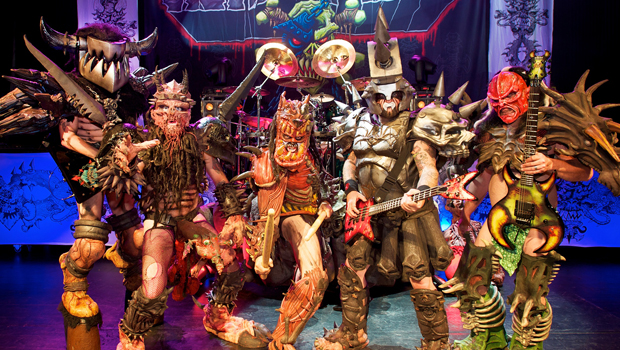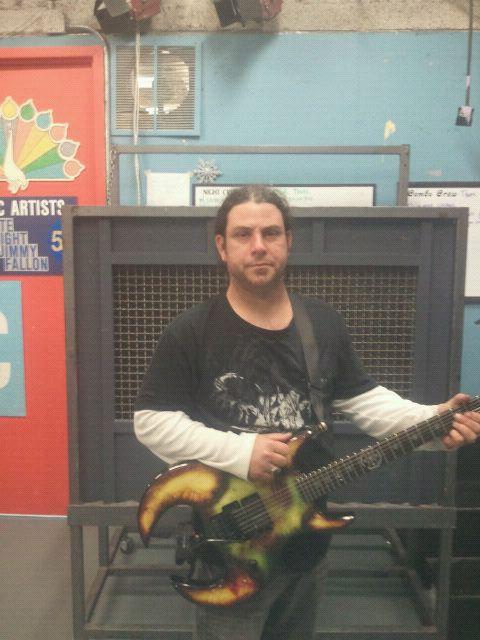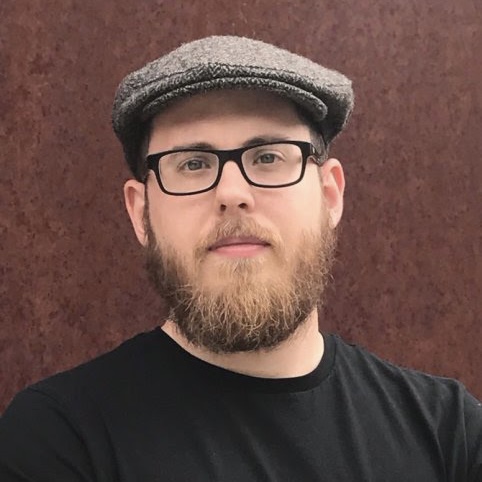
It's a chilly Sunday night in New York City, but it's hard not break a sweat inside Manhattan's Irving Plaza, where Gwar have filled the place to capacity.
It's hard to describe a Gwar show to someone who's never attended one. How does one adequately describe the Jagermonsta, the World Maggot and the infamous Cuttlefish to an outsider? How do you explain that if you go to a Gwar show, you're going to end up covered in blood, bile and any number of other bodily fluids, and still have the night of your life?
One thing's for sure: Beneath all the chaos of a Gwar show, there's still a talented group of musicians who have to not only worry about accurate speed-picking, but do it while being attacked by any number of chainsaw-wielding monsters.
I caught up with Gwar guitarist Cory Smoot -- better known to most as Flattus Maximus -- before their recent show at Irving Plaza to talk guitars, influences and life behind the mask.
[Admiring the custom Flattus guitars] So how did you hook up with Schecter?
CORY SMOOT: Yeah, I was fortunate enough to get my own signature model. When I was with ESP, things were going pretty well, but I wanted to design something Gwar-esque looking, you know? I came up with this style and presented it to ESP. They were stoked but they just had so many people on their roster, it was hard to get anything done.
In the meantime, my other band was on tour with Green Jello and their guitar player was using Schecter. At that point I was in a little purgatory about which guitar company to go with and was maybe looking for a new company. Schecter was more than accomodating. I told them I had this design I wanted to do with all the specs, and man, they had me a prototype within six months. So I've been with Schecter for about three years.
Get The Pick Newsletter
All the latest guitar news, interviews, lessons, reviews, deals and more, direct to your inbox!
The paint job is really cool. Was that your concept?
Originally one of the Gwar guys was gonna do the paint job. We were just going for the Flattus Maximus theme with the dinosaur/lizard skin and the horns. The shape of it has kinda got that triceratops/trilobite kind of style to it; it matches the costume pretty good. The shape's pretty unique too. I mean there are some guitars that kind of look similar -- it's kind of hard to come up with a style of guitar that hasn't been done before.
But Schecter's been selling them through the Musician's Friend catalog. Right now I'm talking to them about doing flat colors, maybe a see-through green or a see-through red, because some people might like the style and the playability but the graphic isn't for them.
Talk about some of the specs on it.
It's made for shredability. It's got the EMG-81 on the bridge, nothing on the neck, on/off killswitch, original Floyd, mahogany body, neck-thru design. It's basic, but it does a great job.
And it looks like you have a six- and a seven-string.
Six- and an eight-string. The eight-string is a prototype. They whipped that up just to see what it would be like. We've got a few songs on the newest record, Bloody Pit of Horror, where we were experimenting with eight-strings. They whipped one of those up as an eight-string. It's weird because the neck is like a sheet of plywood; it's just so flat and wide.
What sort of eight-strings were you using on the album?
We were using Schecter's C8s. Those worked great, too. During the transition we had an ESP eight-string too. It was alright, but the C8 was sort of my introduction to Schecter, and I was like, "Wow, this thing shipped all the way from California and it's perfectly in tune."
Talk me through your pedalboard.
It's pretty simple. All it is is the Rocktron Midi Control Pedal with a Morley Bad Horsie. Then I run through the Rocktron Expression effects units. The rig's pretty plain. In the middle of the mix we run a Rocktron Hush noise gate and a sonic Maximizer, and then a tuner and then the EV REV wireless system.
Gwar's Cory Smoot, aka Flattus Maximus.

You guys have been pretty consistent with putting out a new album every year or two. When can we expect the next Gwar record to hit?
We're actually talking about starting to rehearse some new material when we get home from the tour, and hopefully start recording here in the next half-year -- three to six months, I'd say.
What's the songwriting process in Gwar like?
It differs. This last album we were in kind of a hurry. I was working on a side project called the Cory Smoot experiment, something I've been working on for years. I had come up with some cool stuff and I was going to get [Dave] Brockie to do vocals on it. We were kind of stressed on time and material, and they liked the material so much that we ended up using that as part of it, so that's how it happened this time.
But it happens so many different ways. Sometime we just get together as a band and one person comes up with a cool riff, or sometimes somebody will go on Pro Tools and lay some basic drum beats and lay down some riff ideas, and kind of bring a template song to the band and then the band will bring it to life. Whatever you can think of, we've tried and done. There's even one song where I was just recording some speed-picking exercises and it was to a click, and that ended up becoming our song "KZ Necromancer."
It's always cool. We've always got something cool and something weird around how we create a song, or just how the song comes out of nowhere.
Talk a little bit about your early days as a guitar player. What got you into the instrument?
I was like 2 years old and my dad, he was the local rocker in a band, and I was this little kid looking up at his Marshall stack like it was God. When he'd be practicing, you know, the kick drums, how they put the pillows in there? I'd crawl inside the kick drum and get all comfortable and sleep.
So all my life music's been there. I've had a guitar since I was 2 years old, but it probably wasn't until middle school that I really learned how to play. Before that it was just kind of banging on the guitar or banging on some drums, but by then I was really taking it seriously.
I was 13 and in my first band, already playing shows with some old-time buddies in Richmond -- Ryan Parrish, who's in Darkest Hour now, and Kris Norris, who was in Darkest Hour and now Strait Line Stitch. We were kind of in each other's first bands together. That was really cool to grow up together and us all spread our wings and fly in different directions.
When you really started to take guitar seriously, who were the players that were really influential to you?
I was definitely into Megadeth, Slayer and Pantera. Sabbath, Kiss and Alice Cooper as far back as I can go. My first barre chord was "Revelations" by Iron Maiden. [sings riff.] I'd just play that all day long. I just thought it was the coolest thing -- I thought learning the barre chord was the coolest thing.
What are some of the challenges you face as the guitar player in a band that not only wears full costumes, but also generally has something trying to decapitate you onstage while you're trying to play a song?
It's definitely hard to wear that costume and having to realize that the show is just as just as important as the music, having to realize that sometimes people overlook the music for the show. Of course, being a musician, that's my priority and what I care most about. It's wearing the costume and knowing I could play it a thousand times better. But the cool thing is it pushes me that much harder to play that much better.
You're kicking off a short tour tonight. What can fans expect out of this run of shows? Any surprises?
Yeah, we pulled out some songs from the new record, like "Damnation Under God." We've got some old-school ones, like "Jagermonsta," which is a song that we haven't played in at least 12 years. That's a rare one. "UberKlaw" is one that we've never played live yet. We've got some cool characters. We've got Snooki; of course the maggot is back. Hopefully kids will dig it and die for it. [laughs]
Gwar are now on tour with Every Time I Die and Ghoul. Click here for the latest tour dates.
Josh Hart is a former web producer and staff writer for Guitar World and Guitar Aficionado magazines (2010–2012). He has since pursued writing fiction under various pseudonyms while exploring the technical underpinnings of journalism, now serving as a senior software engineer for The Seattle Times.
“Every tour was the best I could have done. It was only after that I would listen to more Grateful Dead and realize I hadn’t come close”: John Mayer and Bob Weir reflect on 10 years of Dead & Company – and why the Sphere forced them to reassess everything
“Last time we were here, in ’89, we played with Slash on this stage. I don't remember what we did...” Slash makes surprise appearance at former Hanoi Rocks singer Michael Monroe's show at the Whisky a Go Go


![John Mayer and Bob Weir [left] of Dead & Company photographed against a grey background. Mayer wears a blue overshirt and has his signature Silver Sky on his shoulder. Weir wears grey and a bolo tie.](https://cdn.mos.cms.futurecdn.net/C6niSAybzVCHoYcpJ8ZZgE.jpg)

![A black-and-white action shot of Sergeant Thunderhoof perform live: [from left] Mark Sayer, Dan Flitcroft, Jim Camp and Josh Gallop](https://cdn.mos.cms.futurecdn.net/am3UhJbsxAE239XRRZ8zC8.jpg)





